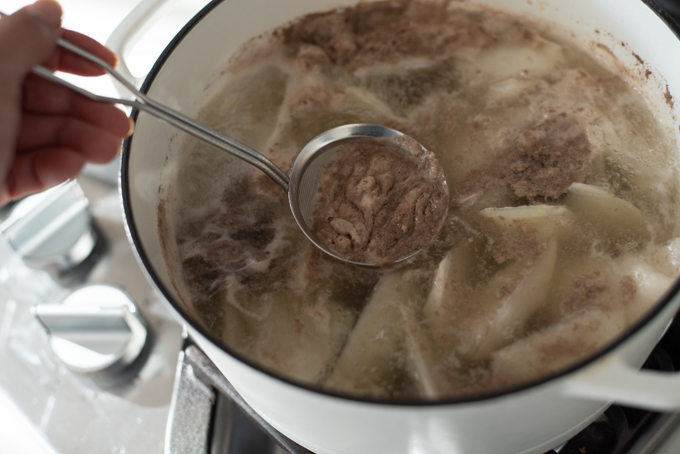Korean beef radish soup (Sogogi muguk) is a comforting, clear broth soup made with tender beef and Korean radish. Perfect for chilly months, this easy Korean soup recipe brings mild, umami flavors to your table. Serve with rice and kimchi for a balanced meal!


Korean beef radish soup, or sogogi muguk (소고기무국), is a traditional Korean soup known for its clear broth and deep umami flavor. Made with tender beef and Korean radish (mu), it’s especially comforting during chilly months when warm, nourishing dishes are craved.
This soup is mild yet full of flavor, making it perfect for both kids and adults. Served with rice and kimchi, sogogi muguk becomes a simple, balanced meal that’s wholesome and satisfying. It’s a Korean comfort food staple, bringing warmth and a gentle sweetness from the radish in every bowl.


Why You’ll Love Beef Radish Soup
- Perfect for cold weather
- Clear, mild, and comforting
- Great for children or those who prefer subtle flavors
- Ready in just 30 minutes with simple ingredients
Korean Radish vs. Daikon Radish


Many confuse Korean radish (mu) with Japanese daikon, but they have unique qualities:
- Shape and Color: Korean radish is shorter, rounder, and has a pale green hue near the top, while daikon is longer and entirely white.
- Taste: Korean radishes are sweeter and mellower than daikon, especially in late fall and winter when their flavor is at its peak.
Korean radishes are perfect for this soup, adding a subtle sweetness to the broth, especially when in season. Beyond soups, they’re also fantastic for making kimchi, particularly cubed radish kimchi known as kkakdugi.
How to make Beef Radish Soup


Prepare the Radish: Peel and cut into large bite-sized pieces. Traditional Korean cooking often uses free-form cutting to create irregular pieces that absorb broth flavor. Or cut into 1/4-inch slices if free-form cutting is not comfortable.


Cook the Beef: In a pot, heat sesame oil mixed with a neutral oil over medium-low heat and brown the beef until fragrant.


Add Radish and Kelp: Add the radish pieces and water. Drop in a piece of dried sea kelp for depth of flavor, then bring the soup to a boil. Remove the kelp once boiling.


Skim and Simmer: As the soup boils, skim off any scum to keep the broth clear. Cover and simmer on low for about 20 minutes to let the flavors meld.


Season the Broth: Add a small amount (1 tablespoon) of Korean soup soy sauce or tuna sauce. Adjust with salt if needed for a balanced, clear broth.


Serving Suggestions
Serve Korean Beef Radish Soup with rice and kimchi for a balanced meal. Many Koreans enjoy dunking rice directly into the soup, adding extra comfort and flavor with each bite. Pair it with baechu kimchi (napa cabbage kimchi) for a full Korean meal experience.
Tips for the Best Korean Beef Radish Soup
- Avoid Over-seasoning: Too much soy sauce or tuna sauce can darken the broth, so keep it light for a clear, inviting appearance.
- Skim the Broth: For the best clear soup, remove any impurities as the soup starts to boil.
- Use Fresh Korean Radish: The taste is best when radish is in season.


Love this recipe? Rate it and share your experience in the comments below! On Instagram? Tag me to showcase your creation. For more delicious recipes, subscribe to our newsletter!


Korean Beef Radish Soup (Sogogi Muguk)
Korean Beef Radish Soup (Sogogi Mu Guk)—a mild, comforting broth with tender beef and sweet Korean radish. Simple to make, it’s perfect with rice and kimchi for a cozy meal.
-
Heat oils in a 4 qt soup pot over med-low heat. Add the beef with a pinch of salt and cook until browned.
-
Pour water, add radish and dried sea kelp. Cover with a lid and bring it to boil over med-high heat. When boiling, remove the sea kelp and discard.
-
Using a small fine mesh strainer, scoop out scums floating on top. Reduce the heat to low and simmer for 15-20 minutes, covered.
-
Add garlic and Korean soup soy sauce or tuna sauce. Add salt to season according to your taste.
-
Add green onion, and pepper. Remove from heat and serve hot with rice and kimchi.
Korean radishes are easily found in most Korean stores. If not available, use daikon radish and add 1 teaspoon of sugar to the soup when simmering.
Calories: 161kcal, Carbohydrates: 9g, Protein: 20g, Fat: 5g, Saturated Fat: 1g, Polyunsaturated Fat: 1g, Monounsaturated Fat: 2g, Trans Fat: 0.01g, Cholesterol: 47mg, Sodium: 353mg, Potassium: 699mg, Fiber: 3g, Sugar: 4g, Vitamin A: 4IU, Vitamin C: 39mg, Calcium: 81mg, Iron: 2mg

